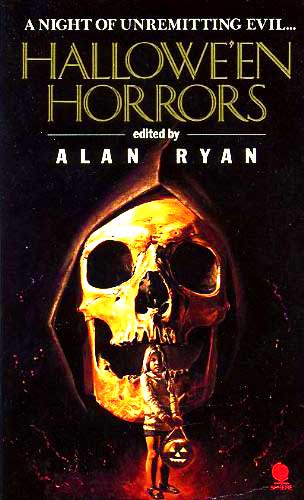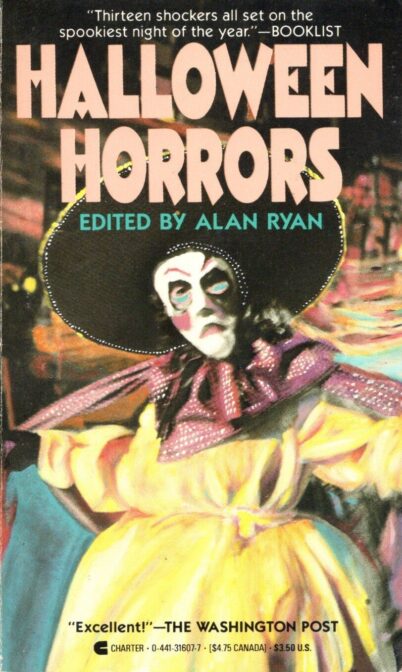Edited by ALAN RYAN (Charter; 1986/87) A 1980s collection devoted to stories about Halloween. Edited by the late Alan Ryan (a.k.a. Alan Peter Ryan), HALLOWEEN HORRORS has become something of a classic in the field (despite being out of print for over thirty years). Does the book warrant its accolades? Let’s see.
A 1980s collection devoted to stories about Halloween. Edited by the late Alan Ryan (a.k.a. Alan Peter Ryan), HALLOWEEN HORRORS has become something of a classic in the field (despite being out of print for over thirty years). Does the book warrant its accolades? Let’s see.
Robert R. McCammon’s “He’ll Come Knocking at Your Door” begins the collection. A memorable exercise in contained intensity, it concerns a family who upon settling into a rural Alabama community learn of a most horrific Halloween ritual.
“Eyes” was drafted by the “Quiet Horror” guru Charles L. Grant, who was urged by Ryan to write something “Really nasty.” An early description of rustling leaves nearly fits that description–“They hissed and crackled, their edges age-sharp and stinging”—but the story overall doesn’t, being a dark-hued psychological study whose horrors, in keeping with Grant’s pedigree, are of the soft-spoken variety. Of a similar hue is “Trickster” by Steve Rasnic Tem, a San Francisco set elaboration on that ever-popular trope of Halloween pranks gone too far. The prankster is an irrepressible gay man whose brother, traumatized by the former’s death, finds himself alone on Halloween night in the city, and comes to believe his sibling might be (un)alive.
“Miss Mack” was the first-ever short story published by the late Michael McDowell. The setting is the Florida town Babylon (also the location of a certain cold moon), where the title character, a “vast, dark and foreboding” woman, takes a teaching job. She befriends a fellow teacher, with that friendship going far beyond platonic perimeters, leading to a curse and a viewpoint shift that sees Miss Mack going from a distant figure to the front-and-center protagonist of a deeply unnerving cavalcade of reality displacement.
“The Halloween House” by Alan Ryan partakes of another popular Halloween trope: the neighborhood haunted house, explored by an assortment of overly inquisitive teenagers. What they discover in this well written account doesn’t involve ghosts so much as a unique, and very Halloween-centric, aspect of the abode itself.
Those are the standouts. Moving a few steps down, we have “Three Faces of the Night” by Craig Shaw Gardner, an evocative but overlong depiction of young folk getting back to the traditions of Samhain, which helped birth Halloween—and virtually the same, in terms of plot outline and page length, can be said for “The Samhain Feis” by Peter Tremayne. “Pumpkin” by Bill Pronzini is the only one of these stories centered on that most important Halloween component: a pumpkin. An evil pumpkin, to be exact, although precisely what the evil entails we don’t learn until the final pages. “Lover in The Wildwood” by Frank Belknap Long is an account of undead love whose effects are of the poetic and transcendent—and so non-horrific—variety. Guy N. Smith’s “Hollow Eyes” deserves credit for a treatment that’s complex and multilayered (not exactly things we’ve come to expect from Smith), but I never found the story very compelling.
Then we have the outright disappointments. In “Pranks” the (mostly) great Robert Bloch offers a depiction of Halloween night mischief by an evil couple whose methodology and motivations are never made too clear. “The Nixon Mask” by Whitley Strieber is a goof about Richard and his time in the White House, portrayed here as a literal house of horrors on Halloween night, 1971, with implications that somehow lead directly to Watergate (which occurred over half-a-year later, so the satire doesn’t quite work). “Apples” by Ramsey Campbell provides a rambling British-centric offering whose main plot strand involves bobbing for apples on Halloween—or, rather, “Hallowe’en.”
So there you have it: I say HALLOWEEN HORRORS is a solid collection and worthwhile purchase (although perhaps not at the severely inflated prices being charged by online sellers). No, it’s not all top-notch, but four great stories is a good ratio for any collection.

